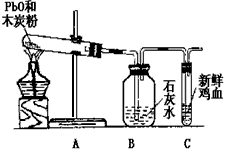小强. 小明和小梅三同学在学习了木炭还原氧化铜的实验后,提出如下问题:“木炭与一氧化铅(化学式为PbO)反应生成铅的同时产生的气体一定全部为二氧化碳吗?”请你和他们一起对产物中气体的成分进行研究,并回答有关问题。

猜想:小强认为:反应产生的气体全部为二氧化碳。小明认为:反应产生的气体全部为一氧化碳。小梅认为:反应产生的气体既有二氧化碳又有一氧化碳。
设计实验:根据各自的猜想,他们共同设计了实验,实验装置如上图(他们在实验中进行了规范操作和细致的观察)。
(1)现象与结论:如果小强猜想正确,装置B. C中的实验现象是 ;如果小明猜想正确,装置B. C中的实验现象是 。如果小梅猜想正确,装置B. C中的实验现象是 。
(2)此实验装置有不足之处,请你对该装置进行改进,具体措施是 。
(3)根据上述实验及学习的木炭与CuO. Fe2O3的反应,请你归纳出单质碳的一项重要用途是 。
(3)石灰水变浑浊,鸡血颜色不变;石灰水无明显变化,鸡血颜色发生变化;石灰水变浑浊,鸡血颜色发生变化
(4)在装置C的出气口接一个尖嘴玻璃管和燃着的酒精灯(或在装置C的出气口用气球或塑料袋收集尾气)
(5)冶炼金属
